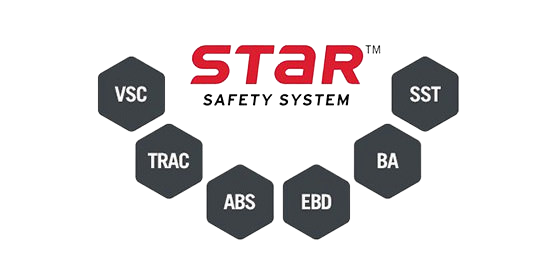
Toyota Star Safety System
The Toyota Star Safety System™ is a network of active traction, cornering, and braking technologies that help the driver to accelerate, steer and stop, especially in slippery conditions or during emergency maneuvers.

Vehicle Stability Control (VSC)
Can modulate the brakes and throttle to help keep the vehicle on course while cornering.
Vehicle Stability Control (VSC) interprets data from a steering wheel position sensor and the ABS wheel-speed sensors to determine if the vehicle is following the driver’s steered path. Suppose the vehicle is deviating from the direction that the steering wheel is aiming the front wheels. In that case, it can reduce engine power and pulse the left- or right-side brakes to help correct the situation.
Vehicles equipped with Electric Power Steering (EPS) can also provide the driver with steering assistance while VSC is taking action. If additional steering angle is needed, the EPS can add power assist in the direction the driver needs to turn… If the driver is turning in the wrong direction for counteracting a skid, the system can reduce steering assist. In either case, EPS is essentially “coaching” the driver to turn in the correct direction for counteracting the skid.
VSC can help keep the vehicle on course by making sure the vehicle’s direction and the direction of the steering wheel agree. And if they don’t, VSC can reduce engine power and slow down the right- or left-side wheels to help compensate

Is the precursor to ABS, where brake pressure is reduced at lightly loaded wheels that are more prone to skid.
When a driver steps on the brake pedal, the tires that carry the least weight are the most prone to skid. This would include the rear tires when a vehicle’s weight transfers forward during braking or the inside tires when a vehicle’s weight transfers to the outside of a turn during cornering. In both cases, momentum shifts weight and reduces the braking grip on a specific set of wheels.
When a driver steps on the brake pedal, the rear wheels can decelerate just a little bit faster than the front wheels. ABS sensors detect this wheel-speed difference before it turns into a full-fledged skid and begins lightly pulsing the rear brakes.

Smart Stop Technology (SST)
Builds on the foundation of braking and traction systems included in Toyota’s Star Safety System.
Smart Stop Technology (SST) builds on the foundation of braking and traction systems included in Toyota’s Star Safety System…
- Vehicle Stability Control (VSC)
- Traction Control (TRAC)
- Anti-lock Brake System (ABS)
- Electronic Brake-force Distribution (EBD)
- Brake Assist (BA)
To provide an added layer of confidence, the driver can stop the vehicle even if the accelerator pedal is fully depressed.
By employing accelerator pedal position sensors, brake circuitry, and vehicle speed sensors, Smart Stop Technology automatically engages when:
- The throttle is more than one-third open (beyond the idle position).
- The vehicle is moving faster than 5 mph.
- The brakes are firmly applied for more than half a second.
When engaged, engine output is cut to the idle position, reducing the load on the brakes.
Smart Stop Technology incorporates sophisticated logic control so that the system cannot be engaged when it’s not needed. In certain driving conditions, inappropriate activation might be inconvenient and could possibly be unsafe.
For example, the system will not activate in 4WD vehicles while driving in the low range. The system will also not activate if the brake pedal is depressed before the accelerator pedal. This allows the driver, for instance, to depress the brake and accelerator pedals simultaneously when starting on a steep hill.
In all circumstances, the driver can cancel activation of Smart Stop Technology by taking his or her foot off the brake pedal.
Vehicles powered by Toyota’s Hybrid Synergy Drive-including
- Avalon Hybrid Prius
- Camry Hybrid and
- Highlander Hybrid
Employ a system that achieves the same effect as Smart Stop Technology.

Traction Control (TRAC)
Helps a vehicle’s drive wheels gain and maintain grip during hard acceleration or acceleration on slippery surfaces.
Traction Control (TRAC) helps a vehicle’s drive wheels gain and maintain grip during hard acceleration or acceleration on slippery surfaces.
By interpreting data from the ABS wheel-speed sensors, TRAC can tell if a drive wheel is turning faster than a non-drive wheel, indicating loss of traction and slippage.
When TRAC detects slippage, the system can automatically reduce engine power until the wheel that is slipping slows and regains grip. If reducing engine power isn’t enough, the braking system will gradually slow that wheel through pulsed brake action. The braking action, in turn, automatically transfers power to the opposite drive wheel; either left-to-right on a 2-wheel-drive vehicle or front-to-rear on a 4-wheel-drive vehicle.

Brake Assist (BA)
Automatically applies increased braking power when it detects that the driver is attempting to make an emergency stop.
In emergencies, some drivers – especially inexperienced ones – often panic and do not apply sufficient pressure on the brake pedal. Brake Assist measures the speed and force with which the brake pedal is pushed to determine whether the driver is attempting an emergency stop.
Suppose the system determines that is the case. In that case, it applies additional brake pressure to allow the driver to take full advantage of the anti-lock braking system. When the driver intentionally eases up on the brake pedal, the system reduces the amount of assistance it provides.

Anti-lock Brake System (ABS)
Helps preserve stopping and steering control by helping to reduce the chance that wheels can lock and skid during hard stops or stops on slippery surfaces.
An Anti-lock Braking System (ABS) uses magnetic wheel-speed sensors to monitor all four wheels while a vehicle is moving. The sensors constantly compare the speed of each wheel by sending this data to an ABS computer.
If the driver steps on the brake pedal, a wheel or wheels begin to decelerate faster than the others, the system recognizes this condition as the prelude to a skid.
When a wheel or wheels look like they are about to skid, ABS rapidly pulses the individual brake at that wheel until it begins to roll at the same speed as the others. While ABS pulses the brake for a wheel that’s about to start skidding, it maintains brake pressure on the wheels with better grip, so the vehicle continues to decelerate.
Keeping all four wheels turning, even as the vehicle decelerates, helps the tires maintain a better grip on the road. A skidding tire has less braking and cornering capability than a rolling tire. In fact, a skidding front tire can generate very little cornering force, so ABS helps improve a driver’s ability to stop and steer at the same time.
EVERYONE DESERVES TO BE SAFE!


